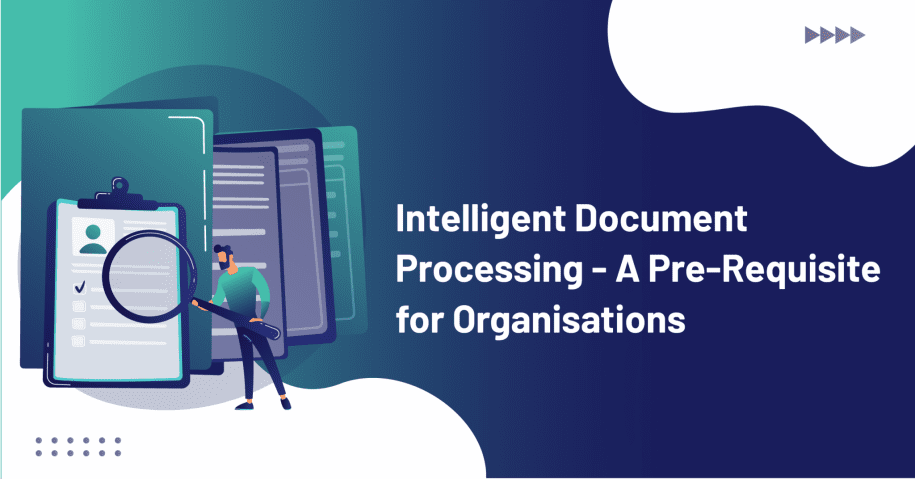Data is a component that is extremely important for organisational development and daily workflow. However, one of the never-ending challenges that many enterprises face today is to use the abundant data at their disposal in brilliant ways that are most significant to their growth, development and success.
Even for the human task force, processing a large amount of received data is challenging. Nevertheless, advances in technology, especially Artificial Intelligence, have enabled computer-trained algorithms to scan, read and comprehend virtual and paper-based documents. This well-known technology is called IDP – Intelligent Document Processing, an AI Document processing method garnering attention and popularity in many areas.
What Exactly is Intelligent Document Processing?
Intelligent Document Processing or IDP is the procedure in which the algorithms smartly capture data and streamline the processing of documents. Irrespective of what kind of document it is – paper-based or digital, long or short, structured or unstructured, IDP’s objective is to extract information, verify it, process it, and give a reasonably good output as expected by the user. Data is central to your organisation’s workflow and must be methodically organised. For this reason, data acquisition document processing solutions like IDP are fundamental to the success of a business.
IDP platforms use Artificial Intelligence, machine learning (ML), optical character recognition (OCR), computer vision (CV), and intelligent character recognition (ICR) technologies to improve the accuracy of data. You can extract data or process IDP in three ways –
- Manual data extraction
- Template-based data extraction
- Intelligent document automation
How is IDP Helpful?
- The primary purpose of IDP platforms is to decrypt unreadable, unstructured, or complex content using ICR – Intelligent Character Recognition.
- It helps streamline the supply chain and assists in understanding various kinds of documents like invoices, manifests, barcodes, etc., for fast operations.
- IDP can be useful in digitising paper documents by simply using a scan and convert formula. It helps transform paper-based documents into machine-readable file formats that contain searchable text.
- IDP is all about AI document processing that automates document creation and has access to various data sources that help create detailed reports, simplify complex legal documents, and much more.
- IDP helps manage documents and data, saves them for retrieval or archiving, and automates compliance with record retention requirements.
- The IDP platform should be industry-centric, flexible, extended to handle billions of extracts daily, and integrated with cloud and on-premises systems.
Three Pillars of Intelligent Document Analysis
When it comes to new intelligent document automation, its three pillars – OCR can be thought of as “eyes,” machine learning as “brain,” and RPA as “arms and legs.”
1. Optical Character Recognition (OCR) is a technology that recognises any text and transforms it into a machine-readable format but does not understand the meaning or context. Therefore, a “brain” is required.
2. Machine learning concentrates on building algorithms based on data, training models, processing new data inputs, and allows you to make your own decisions. IDP relies heavily on ML-driven technologies such as –
- Computer Vision (CV)
- Natural Language Processing (NLP)
3. Robotic Process Automation or RPA collects information from specific sources and communicates with other management systems to fully automate the document control process.
How is IDP Different from Document Capture?
The biggest difference between IDP and traditional capture is its innovative ability to process documents. Traditional document capture discontinued innovation or transformation more than a decade ago.
Document capture was developed when saving computing power was necessary. Its system was not designed for the scalability required by today’s data-intensive applications. Also, rebuilding software across the platform to meet IDP requirements is expensive.
The large customer base of document capture companies is another reason for switching to IDP, as companies do not want to disrupt the customer’s existing workflow by requesting an upgrade. Instead of updating the captures, they have moved on to innovative robotic process automation and rebranded them to appear to have IDP capabilities.
How is IDP Used in the Finance and Aviation Industries?
IDP in Finance and Accounting
Accounting and finance professionals process a lot of sensitive information every day, whether they work in a professional accounting firm or a large organisation’s finance department. IDP has become a prerequisite for many companies as it helps the finance department process the massive collection of data quickly. Finance and accounting departments need IDP to –
- Manage the company’s finances
- Manage salaries and ensure that all employees are paid
- Calculate final tax return
- Ensure invoice payment
- Compliance
- Scanning receipts, bank statements, bills, contracts, etc., to find the most important facts and numbers.
Using IDP, professionals can spend more time focusing on other important work areas.
IDP in Aviation
A major part of the data aviation companies collect is unstructured or in the form of sheets, emails, text survey data, etc. With the help of AI, IDP and machine learning, the aviation industry can convert this unstructured data to solve a variety of challenges like –
- Data extraction from clips, pictures and sounds
- Data conversion using audio extraction, text extraction, prototyping and validation
- Classification, cloud, parallel processing, network settings and context search
- Real-time search queries and data transformations
Conclusion
The advent of technologies like IDP (Intelligent Document Processing) extends human understanding at all stages of document data integration. Intelligent Document Processing (IDP) is a document processing solution for automating data extraction projects and can transform both unstructured and semi-structured data into structured, actionable information to automate document-centric business processes end-to-end.


Leave a Reply